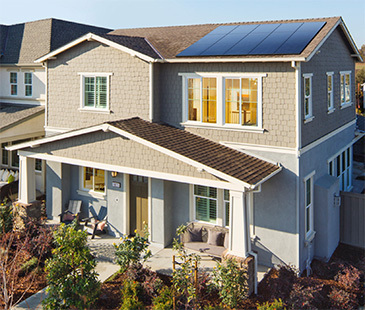Solar FAQ for multifamily builders, developers and architects
How much of a community’s electrical consumption can be offset by solar?
Given enough space for solar panels, it’s possible to size a large system enough to offset more than 100% of a multifamily community’s estimated energy consumption. While some multifamily developers choose to size a system just large enough to meet minimum requirements, many opt for a more comprehensive sizing strategy to achieve greater returns on the initial investment and lock in low-priced energy for the future.
How will solar impact the economics of the project?
Although adding solar may require significant capital investment for those opting for an upfront purchase, SunPower offers several financing options which can reduce or even eliminate these out-of-pocket expenses. In either case, the savings and incentives with solar far outweigh the costs and can bring fantastic returns for many years to come. With multifamily solar, it is possible to see significant improvements to the net operating income (NOI) and cap rate for the community.
Are there solar code requirements to consider?
Yes. In California, and increasingly nationwide, authorities are adopting formal laws and building codes requiring high energy efficiency construction standards, including requirements for on-site solar generation. For multifamily communities in California, code requires solar on every residential unit in the community (with very few exceptions).
Where are the electrical points of interconnection (POIs)?
In consultation with the SunPower multifamily team, the number of POIs is a choice each developer can make for themselves based on the logistics of their particular community. Many utilities offer virtual net energy metering (VNEM) programs which allow the owner to receive credits for the excess solar generation at one or more meter locations and apply the credits toward many other meters’ energy usage throughout the community. Some developers opt to apply credits toward house account meters only, while others share credits with tenant meters as well. By optimizing the overall number of POIs for a given community it is possible to lower the overall costs required for solar throughout the development.
What is the approximate system size necessary to meet code requirements and electric loads?
The system size required to meet local codes may be different than what is necessary to meet expected consumption. In either case, solar system sizing is based on many factors, including but not limited to:
Climate zone
Conditioned square footage
Expected size/type/runtime for major electrical appliances
Space available for solar arrays
Type/specifications of solar module and inverter
Racking system, tilt-angle, and orientation of modules
Shading of arrays
Wire size/type/length
Dusting losses
For solar system sizing on a specific project, please contact the SunPower multifamily team.
Which areas within the development are best for placing solar arrays?
Typically, systems can be mounted on sloped roofs using SunPower® InvisiMount® racking, on flat roofs using either tilt racking or SunPower® Helix® ballasted racking systems, on builder-designed carport structures, on SunPower Helix carport solutions, or on some combination of any of these approaches. The preferred area for mounting solar arrays is up to the developer and architect. SunPower can help identify the preferred location for equipment while balancing the solar system sizing target, aesthetics, and financial objectives for each project.
What are the space requirements for the desired system wattage?
Depending on your desired placement and size, our team can work with you to identify the best area for a solar system. SunPower’s higher module efficiencies help to optimize the design and reduce the amount of space needed for solar.
Why choose SunPower solar technology?
SunPower offers superior solar module technology operating at the highest efficiency,*SunPower M-440 panels offer the highest efficiency of any commercially available solar panel based on the top 20 panel manufacturers by market share in the US (per Wood Mackenzie US PV Leaderboard Q3 2022 report). with clean aesthetics, and an industry-leading warranty. SunPower module options come in different energy wattage, size, and aesthetic combinations to accommodate most situations. If areas available for solar arrays do not present a major challenge, SunPower can offer standard-efficiency, commercial-aesthetic technology for a cost savings. However, if aesthetics and efficiency are the priority, SunPower has the world’s most efficient solar module available*SunPower M-440 panels offer the highest efficiency of any commercially available solar panel based on the top 20 panel manufacturers by market share in the US (per Wood Mackenzie US PV Leaderboard Q3 2022 report). with attractive visual appeal. SunPower can also provide a variety of options related to inverter design, racking, on-site battery storage, virtual solar metering, electric vehicle charging, energy billing software, and more. To optimize the right technology selections for your project, please reach out to our team to schedule an initial discovery meeting and obtain a written estimate.
Is there a way to aesthetically feature the solar installation to promote the community?
Many multifamily architects and developers are looking for successful ways to feature the community’s commitment to sustainability. Rather than attempt to hide the solar installation, some want to show off their solar system in a sleek, aesthetically appealing way. Whether it’s rectangular-shaped arrays of all-black modules on a black-shingle roof, handsome solar carports structures painted to match the architectural theme of the community, or a modern solar trellis above an outdoor greenspace, there are many ways to prominently feature solar and enhance the attractiveness of the community.
Can the solar be hidden from view at ground level?
Yes, there are several methods for hiding the solar installation from view. For instance, modules can be mounted in low-profile on flat roof surfaces and hidden behind parapet walls. Solar arrays can also be flush-mounted on sloped roof sections with no visible line-of-sight from ground level (such as with three-story interior courtyard roofs). Solar arrays can be ground mounted in less visible locations (like behind the building) or placed on top of roofed carport structures that would obscure their view from under the structures themselves.
What are the general setback requirements (fire, plumbing, HVAC)?
Depending on the type of roof section (flat, pitched, gabled, dormer), and the specific Authority Having Jurisdiction (AHJ) for the community, there are specific setback requirements for solar arrays to allow for safety in movement, ventilation, and general roof mobility. Similarly, there are detailed setback requirements around roof vents, skylights, hatches, ladders, cables, ducting, HVAC units, walking paths, etc. SunPower can optimize your solar design while simultaneously navigating all setback requirements for the AHJ.
Do solar carports make sense?
Often in multifamily developments the most desirable location for solar arrays is the parking lot. While there may be added costs associated with the carport structure itself, there are several potential benefits, including:
Capitalizing on large unshaded areas to maximize solar performance
Applying major federal tax incentives (consult your tax professional)*Tax credits subject to change. SunPower does not warrant, guarantee or otherwise advise its partners or customers about specific tax outcomes.
Installing at ground-level reduces installation costs
Ensuring clean solar array aesthetics
Providing valuable shade to parking and/or common areas
Locating solar generation near electric vehicle chargers
How can solar be integrated with EV charging?
Often in multifamily developments the most desirable location for solar arrays is the parking lot. While there may be added costs associated with the carport structure itself, there are several potential benefits, including:
Capitalizing on large unshaded areas to maximize solar performance
Applying major federal tax incentives (consult your tax professional)*Tax credits subject to change. SunPower does not warrant, guarantee or otherwise advise its partners or customers about specific tax outcomes.
Installing at ground-level reduces installation costs
Ensuring clean solar array aesthetics
Providing valuable shade to parking and/or common areas
Locating solar generation near electric vehicle chargers
How can solar be integrated with energy storage?
Whether simply for back-up power during an outage, or to maximize energy export rates during peak hours, energy storage technology and on-site battery storage is poised to be a major component to multifamily energy infrastructure in the years to come. Solar as a source of renewable energy naturally fits with battery technology to offer consistent daily charging at relatively low costs. However, designing the appropriate energy storage solution and incorporating that solution with the correct solar design can be complex and requires expertise. SunPower has storage experts on staff that can help weigh all considerations to identify feasible energy storage options.

